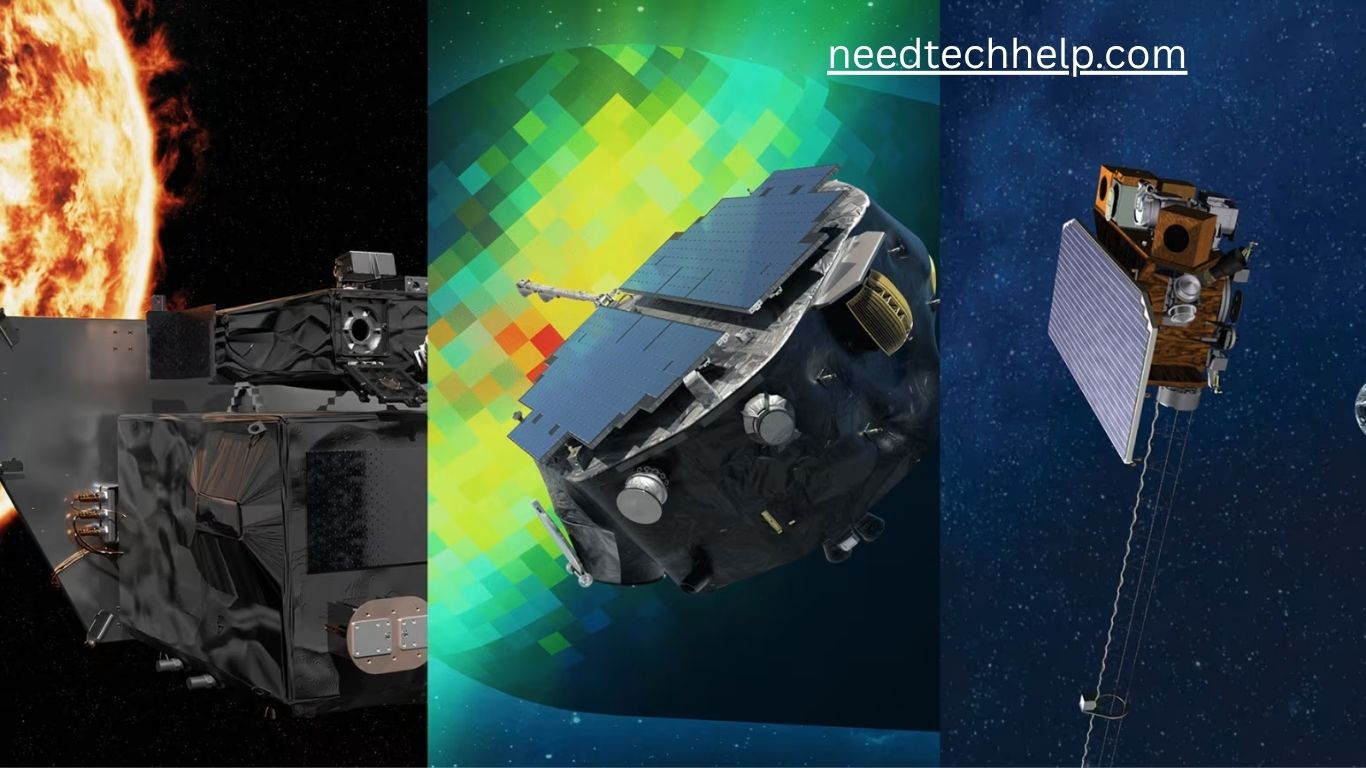Encasing our solar system is a vast, invisible bubble known as the heliosphere — a natural shield that protects planets from dangerous cosmic radiation. NASA’s latest mission, the Interstellar Mapping and Acceleration Probe (IMAP), is set to reveal the mysteries of this enigmatic region, providing astronomers with unprecedented insights into the forces shaping our cosmic neighborhood.
The heliosphere originates from the solar wind, a constant stream of charged particles emitted by the Sun. Acting like a protective bubble, it shields the solar system from high-energy cosmic rays that permeate the Milky Way galaxy. Alongside Earth’s magnetic field, the heliosphere plays a critical role in sustaining life on our planet and may have influenced conditions on planets like Mars in the distant past.
Over the decades, multiple spacecraft have contributed to understanding the heliosphere. Notably, the Voyager 1 and 2 probes ventured beyond its boundary, providing invaluable data about interstellar space. While previous missions laid the groundwork, IMAP is uniquely designed to explore how the Sun generates its solar wind and how that wind interacts with interstellar space at the edge of the heliosphere — a boundary located roughly three times the distance from Earth to Pluto.
Equipped with ten advanced scientific instruments, IMAP will fill critical gaps in heliospheric mapping. By capturing high-resolution images and measuring energetic particles, it will help scientists better understand how this natural shield protects our solar system from cosmic rays — some of the most energetic and potentially harmful particles in the universe.
Read More: http://needtechhelp.com/breaking-cxmt-set-to-ignite-shanghai-market/
Mapping the Heliosphere
The concept of the heliosphere emerged in the late 1950s when scientists studied cosmic rays and the solar wind. They hypothesized that the Sun’s magnetic fields and solar wind create a protective boundary around Earth and the entire solar system.
The first concrete evidence came from Mariner 2, which conducted a successful flyby of Venus in 1962 and measured the solar wind directly. Later, Pioneer 10 and 11 and the Voyager probes provided additional data, confirming the heliosphere’s existence and revealing its comet-like shape.
Voyager 1 crossed the heliosphere’s boundary in 2012, followed by Voyager 2 in 2018, giving scientists snapshots from two distinct locations. Yet, much of the heliosphere remains uncharted, prompting the need for high-resolution mapping. This is where IMAP’s cutting-edge instruments come into play. With imaging capabilities 30 times faster and sharper than previous satellites, IMAP promises a more comprehensive understanding of the heliosphere’s outer boundaries.
Once IMAP reaches its operational orbit about 1 million miles from Earth in roughly three months, it will monitor the solar wind in real time, study particles traveling from the Sun, and map the heliosphere’s boundary located between 6 billion and 9 billion miles away. It will even gather data from interstellar space beyond our solar system.
A key focus of IMAP is energetic neutral atoms (ENAs) — uncharged particles formed when high-energy ions collide with slower neutral atoms. Because ENAs are unaffected by magnetic fields, they travel in straight lines, allowing IMAP to trace them back to their origins. By tracking these particles, IMAP can create detailed maps of the heliosphere’s invisible boundaries.

“IMAP will generate incredibly detailed, evolving images of the interaction region,” explained Dr. David McComas, IMAP’s principal investigator and astrophysicist at Princeton University. “It will clarify how the heliosphere shields our solar system and what that shielding looks like.” McComas also noted that heliospheres are not unique to our Sun; bright astrospheres have been observed around other stars.
Advancing Space Weather Forecasting
IMAP launched alongside NASA’s Carruthers Geocorona Observatory and NOAA’s SWFO-L1 (Space Weather Follow-On Lagrange 1) on a Falcon 9 rocket from Kennedy Space Center, Florida. The Carruthers mission will observe Earth’s exosphere, the outermost layer of the atmosphere, capturing its faint ultraviolet glow to better understand its shape, density, and response to space weather.
Named after Dr. George Carruthers, who developed the first ultraviolet camera placed on the Moon during Apollo 16, the observatory will monitor changes in the exosphere caused by solar activity. This data will provide insights into how space weather affects Earth’s atmospheric boundary.
The SWFO-L1 satellite, meanwhile, functions as a solar storm detector, delivering early warnings to protect astronauts and critical satellites. As human space exploration ventures farther from Earth, such monitoring becomes increasingly vital. Equipped with a compact coronagraph telescope, SWFO-L1 captures images of solar storms and tracks the solar wind, sending real-time data to NOAA’s Space Weather Prediction Center. Compared to older missions like the Solar and Heliospheric Observatory (SOHO), SWFO-L1 reduces data latency from hours to just 30 minutes, enhancing rapid response capabilities.

“SWFO-L1’s data is essential for keeping the lights on, planes flying, and satellites safe,” said Clinton Wallace, director of NOAA’s Space Weather Prediction Center. “It ensures America is ready for whatever the Sun sends our way.”
The Future of Heliophysics
By mapping the heliosphere and improving solar storm forecasting, these missions promise transformative insights into our cosmic environment. Understanding the heliosphere not only enhances our knowledge of solar wind dynamics and interstellar interactions but also strengthens protection for astronauts, satellites, and terrestrial infrastructure.
IMAP’s observations will complement decades of data from the Voyager probes, Pioneer missions, and IBEX (Interstellar Boundary Explorer), revealing the heliosphere’s structure in unprecedented detail. This integrated approach marks a new era in heliophysics, combining cutting-edge technology, precise measurements, and international collaboration to unlock the secrets of our solar system’s invisible shield.

The heliosphere is more than a cosmic curiosity; it is a life-sustaining guardian, protecting Earth from high-energy cosmic radiation while shaping the conditions that allow planets to thrive. NASA’s latest fleet of missions represents humanity’s most ambitious attempt yet to understand this enigmatic region, providing insights that will influence not only space exploration but also our understanding of life beyond Earth.
Frequently Asked Questions:
What is the heliosphere?
The heliosphere is a massive, bubble-like region surrounding our solar system, formed by the solar wind. It acts as a protective shield against harmful cosmic radiation from the Milky Way.
Why is the heliosphere important?
It protects planets, including Earth, from high-energy cosmic rays. This shielding helps maintain conditions suitable for life and influences the space environment of other planets like Mars.
What is the new mission exploring the heliosphere?
NASA’s Interstellar Mapping and Acceleration Probe (IMAP) is the latest mission. It studies how the Sun produces solar wind and how that wind interacts with interstellar space at the heliosphere’s boundary.
How does IMAP study the heliosphere?
IMAP measures energetic neutral atoms (ENAs) and tracks solar wind particles to map the heliosphere’s boundary. Its instruments provide high-resolution imaging and real-time observations.
How far is the heliosphere’s boundary?
The heliosphere extends billions of miles from the Sun, roughly three times the distance between Earth and Pluto. IMAP will study its boundary located between 6 billion and 9 billion miles from the Sun.
How does this mission help with space weather?
By monitoring solar wind and energetic particles, IMAP helps predict solar storms. These storms can affect satellites, communication systems, power grids, and astronauts in space.
How is IMAP different from previous missions?
Unlike earlier missions like the Voyager probes or IBEX, IMAP uses faster, higher-resolution instruments. This allows it to map the heliosphere’s structure more accurately and capture detailed real-time data.
Conclusion
The heliosphere is more than just a cosmic boundary — it is a dynamic shield that safeguards our solar system from high-energy radiation, playing a vital role in preserving life on Earth and shaping planetary environments. NASA’s IMAP mission, alongside its companion satellites, marks a new era in heliophysics, offering unprecedented insights into the solar wind, space weather, and the hidden frontier beyond our Sun. By mapping the heliosphere in remarkable detail and tracking the particles that define its boundaries, scientists are not only unraveling the mysteries of our cosmic neighborhood but also enhancing our ability to protect astronauts, satellites, and critical infrastructure from the Sun’s powerful storms.











